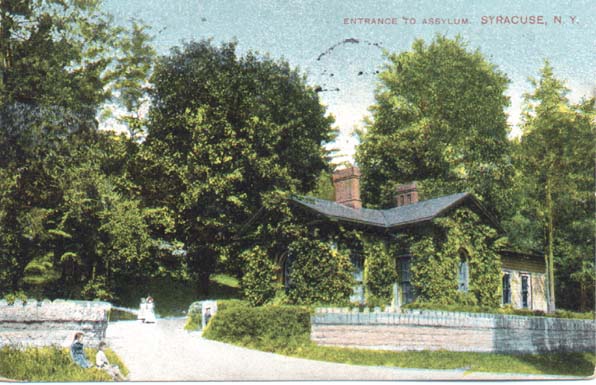Onondaga County Orphan Asylum, 1845-1896
Source: Onondaga’s Centennial, Vol. I, Edited by Dwight H. Bruce, The Boston History Company, 1896, pp. 320-322
This beneficent institution has enjoyed a long and honorable life, its fiftieth anniversary having been celebrated in 1895. The asylum had its inception in a school which was opened on West Water street, under the auspices ofa number of benevolent women, some time between 1840 and 1840, and supported by contributions. The school was for the benefit of poor children and was under direct charge of Miss Ann Mead. Sufficient subscriptionswere finally received to enable the school authorities to erect a buildingfor it on East Onondaga street, near the site of the present library. When the village in 1839 made provision for teaching all children of whatevercondition in life, the work of this benevolent body seemed to be at an end. The school building was sold for $427.38, and this fund remained idle aboutthee years. In 1841 the women of the school association, and others,turned their attention to the care of orphan children. In October ofthat year a new association was formed, the funds of the old one were turnedover to it and the good work began. The house in South Salina streetnow occupied by the Women’s Christian Association was opened in May,1845, and sheltered ten boys and five girls, but was supported by voluntarycontributions, the fund being kept in reserve for the purchase of a new building. In 1846 the Syracuse Academy building, which was so long a landmark in thecity, was purchased for $3,000 and here the asylum found a permanent location. In 1861 the late Horace White erected a building suitable for a day school and also for Sunday services and at this time, though the family had grown in proportion to the rapid growth of Syracuse, it was felt that every necessity had been provided and until 1882 the work was carried on without furtherchange. At this time the academy building was pronounced by the cityauthorities to be no longer safe or suitable for the growing needs of theinmates and in 1885 the present handsome structure was ready for occupancy.
Presidents of the Board of Trustees and the Board of Managers from the beginning of the work to the present date were John Durnford, Timothy Porter, Ira H. Cobb, J. J. Glass, H. L. Duguid, Peter Burns, C. P. Clark, Mrs. Harvey Loomis, Miss Mary Bliss, Mrs. E. W. Leavenworth, Mrs. Mary E. Durnford, Mrs. George F. Comstock, Mrs. H. A. Dunlap, Mrs. William A. Judson, Mrs. Ira H. Cobb, Mrs. E. D. Dickinson.
The management of the asylum is largely entrusted to the Board of Managers consisting entirely of women from various churches in the city and a Board of Trustees composed of representative Syracuse men, who act as an advisory board. A meeting of the two boards is held once a year, and one meeting each month is held by the Board of Managers. Mrs. E. D. Dickinson,who for fifteen years performed the duties of secretary of the Board of Managers, is now president of that organization. Her long experience in the work, her sympathy and good judgment made her the choice of her co-workers, and their wisdom in placing her at the head of so important a work is already proven.
Mrs. Hills, the matron, has occupied her present position for fifteen years, and to her wisdom and kind heart are largely due the excellent conditionof the children and the orderly service of those who are under her direction, in whatever capacity they may serve. Children are admitted to the asylum at from twenty months to twelve years of age and retained until they arenot more than fourteen. They are never sent from the institution without due precaution as to their future welfare. Good homes are constantly being offered in which they may be placed when they arrive at a suitableage, and it is never necessary to look beyond the boundaries of our own county for charitably-disposed people, who will adopt and care for such children as it is thought best to send out. Such persons are required to bring children back to the institution at the end of three months, when, if the child seems to be properly cared for and contented, papers of adoption are made out which demand that the guardian shall keep the child in school until fifteen years of age and must provide for him comfortably. The children’s secretary and the frequent letters to the matron are here great safeguards.
Submitted 21 November 2000 by Pamela Priest
Updated 22 April 2006 by Pamela Priest
